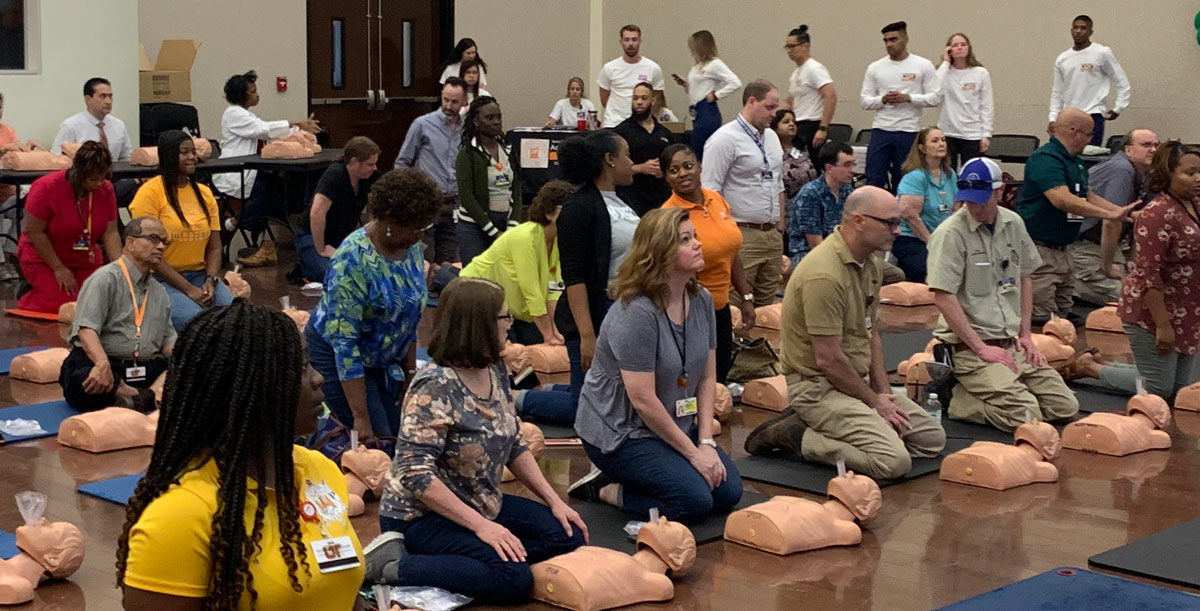CPR and AED
Sudden cardiac arrest (SCA) is a leading cause of death in the U.S. and usually occurs at home witnessed by a loved one. Less than 15% of victims survive, and only 41% receive bystander CPR, which can double the chance of survival. The best treatment for SCA is CPR with good-quality chest compressions and an electric shock from an Automated External Defibrillator (AED).
The Campus AED Program at UT Health Science Center aims to train every employee to use an AED and provide effective CPR. AEDs are strategically placed in buildings and police cars throughout campus.
In Case of an Emergency
In case of an emergency on campus, call Campus Police at 448-4444 and they will contact Campus Police, EMS, and UHS health professionals.
Upcoming CPR and AED Training
November 14, 2025 | 8:45 am and 12:45 pm
SAC- OD Larry Dining Hall
Sign Up for the November 15 CPR and AED TrainingAre you and your co-workers prepared to respond to a cardiac emergency?
New research suggests that 50% may not be.
Source: 2017, AHA Mediagenic Survey Results; 2017, AHA with Edelman Intelligence; 2017, AHA with BLR Media; Postgrad Medical Journal, October 2007.
With 10,000 cardiac arrests annually in the workplace, most individuals across industries believe that being trained in CPR and AED use is important, but many have never received training.
Do you know where the closest AED is located?
AED Use Report
In the occurrence of the use of AED or CPR on campus. Please fill out the following
form and send to Kelly Rogers, PharmD krogers1@uthsc.edu, and LouiseLaFlora, MD llaflora@uthsc.edu.
AED Information
An Automated External Defibrillator (AED) is a device that can provide an electric shock to a person experiencing SCA, if necessary. The AED operates automatically, but users must know how to use it correctly, as well as how to perform high-quality CPR, to help save a life.
The American Heart Association (AHA) encourages the use of AEDs to increase the survival rates of people who have heart-related emergencies. CPR should be initiated immediately after a person collapses with SCA, and the use of the AED should ideally be within 3 to 5 minutes to ensure a successful outcome for the victim.
Why Get CPR Certified?
 The Campus AED Program at UT Health Science Center aims to train every employee to
use an AED and provide effective CPR. AEDs are strategically placed in buildings and
police cars throughout campus.
The Campus AED Program at UT Health Science Center aims to train every employee to
use an AED and provide effective CPR. AEDs are strategically placed in buildings and
police cars throughout campus.
When someone experiences a cardiac arrest, their chances of survival largely depend on receiving immediate CPR from someone nearby. Unfortunately, nearly 90% of people who suffer cardiac arrest outside of the hospital setting do not survive. However, performing CPR in the first few minutes can double or even triple the chances of survival.
Communities like UT Health Science Center with comprehensive AED programs, including CPR and AED training for employees, can significantly increase the survival rates for cardiac arrest victims. UT Health Science Center offers free CPR training to all employees every year. This training is designed to teach the basic skills of CPR and how to use the AEDs available on campus. Upon completion of the training, employees will receive certification from the AHA that is valid for two years. To ensure they maintain their skills and knowledge, employees are encouraged to renew their certification at least every 2 years. Please note that this class does not meet the AHA Basic Life Support requirements for health care providers.
Get CPR Certified through UT Health Science Center's Campus AED Program
Contact
For additional information regarding CPR or this course, please contact Dr. Kelly Rogers, Campus AED Program Coordinator at krogers1@uthsc.edu.
